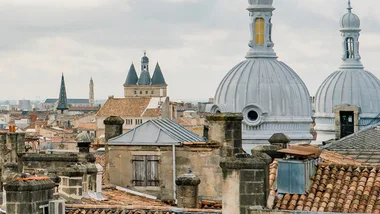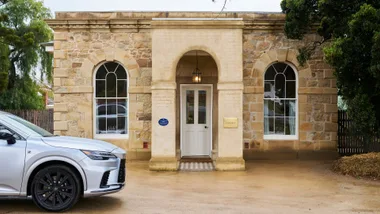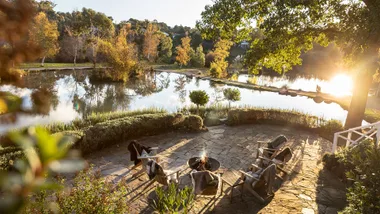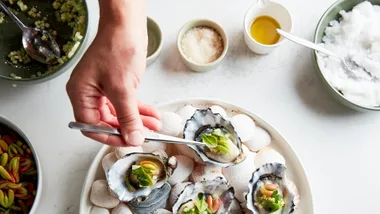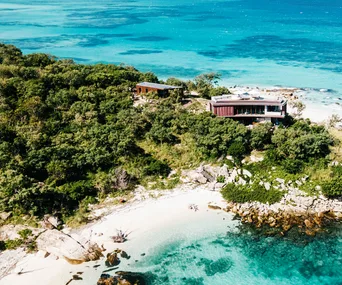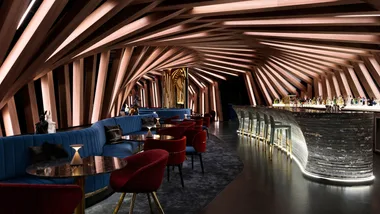Out on a limb in the extreme north-east corner of Italy, far closer to Vienna than to Rome, Trieste was part of the Austro-Hungarian empire for centuries. And you can tell. On arrival, during a brief reconnaissance drive around the centre, I see the Habsburg presence everywhere. Piazza by piazza, what seems like the entire dynasty appears in a succession of solemn statues – from Leopold I, Holy Roman Emperor from 1604-1705, to Empress Elizabeth, “Sisi”, the consort of Emperor Franz Joseph, who came to a sticky end when she was stabbed to death by an Italian anarchist in Geneva. No wonder the city was once nicknamed “Vienna by the Sea”.

Entrance to Palazzo del Comune in Piazza dell’Unità d’Italia
Down on the promenade, from the Canal Grande where small boats rest at their moorings to the Savoia Excelsior Palace, Mitteleuropa meets the Med. On one side are grandiose 18th- and 19th-century buildings, on the other piers and jetties stretch into the water like fingers. Halfway along, the city’s pièce de résistance, the Piazza dell’Unità d’Italia, is lined on three sides by the Neoclassical and Baroque-influenced façades of grand civic and commercial palazzi. At the eastern end, the immense Palazzo del Comune, or town hall, looms over the waterless Fountain of the Four Continents, an homage to Trieste’s penchant for international trade. The point is reiterated by the western end, the feature that gives the piazza its wow factor. It opens directly onto the sea, hence onto the world.

Gran Malabar wine bar
To turn their empire from continental to maritime, the Habsburgs developed the city into a commercial seaport. The Imperial Maritime Government was based here from 1850, and by the end of the 19th century Trieste was being dubbed the “third entrance of the Suez Canal”. A local nobleman, Barone Pasquale Revoltella – whose sumptuous town house on Piazza Venezia is now a museum and well worth a visit – was once the largest private shareholder in the Suez Canal Company. “A colossal emporium and a prodigious trading centre” is how Jules Verne described Trieste in 1874, and the bill of lading “Via Trieste” was familiar on docksides the world over.
After World War I, the city became Italian and Mussolini laced it with more overblown architecture, this time in the Fascist style. During World War II, it was first commandeered by the Germans, then carved up by the Allies. Contested by the former Yugoslavia at the start of the Cold War, Trieste was eventually handed back to Italy in 1954. It now found itself amputated from its hinterland, hanging from the rest of the country by a fine thread of coastline, hemmed in by Yugoslavia. A poll carried out a few years ago claimed 70 per cent of Italians didn’t realise Trieste was part of Italy at all. “We are at the eastern limit of Latinity and the southern extremity of Germanness,” said a former mayor.
.jpg?resize=1024%2C877)
Ponte Rosso, over the Canal Grande
In a city with an Austrian past, I’m lucky to have a couple of Viennese friends as guides: writer Georges Desrues, who lives in Trieste, and his partner, stage actor Karin Kofler, who commutes from Vienna, a five-hour drive away.
On my first evening, they take me to the Carso Plateau, atop the cliffs that rear steeply above the dusty San Giusto quarter, the Old City. We follow the route of the tramway that climbs to the Slavic village of Opicina. The tram is an attraction in itself: at some points, the gradient is so steep it has to be shunted by a funicular engine. The plateau is a place of pliable limestone that has produced a dramatic landscape dotted with depressions, crevasses and gorges. It’s German name, Karst, and the adjective “karstic” have been adopted by geologists to describe this phenomenon tout court.

View to Trieste from the Carso Plateau
Our destination, halfway up, is an osmiza, a sort of country inn characteristic of the Carso since 1784, when Emperor Joseph II issued a decree allowing peasants to sell their produce at their cottages for eight days a year (osmiza derives from the Slovenian “osem”, meaning eight). Today osmize serve charcuterie, hard-boiled eggs, cheese, bread and wine, and are marked by a frasca, a leafy branch, hanging at the gate or on the roadside, where the signs are bilingual, in Italian and Slovene.
We settle on a terrace with a few tables and benches under a pergola. Georges tells me that his countrymen are buying property in Trieste, seeking a residence on the sea just as the Habsburgs used to do. One such is his friend Erich, an architect, who joins us with his wife, Barbara, and their teenage daughter, Nina. They’re renovating a house in the city and are here on a weekend break from Vienna. Erich tells me they’ve been visiting the city for at least 20 years, that they’re in love with the place.
“You watch, it’ll grow on you too,” he says.
I walk to the balustrade and take in the view: the Istrian peninsula to the south, the cranes and warehouses down at the docks, the ferry setting sail for Istanbul, the grid pattern of the city piazze and avenues, the purple sunset over the Adriatic to the west, the backdrop of the Carso. I’ve been here only a couple of hours but Erich is right – Trieste is growing on me already.
.jpg?resize=877%2C1024)
The charcuterie and cheese platter at Osmiza Zidarich
At the next table, a bunch of boisterous Istrians are drinking white wine and talking loudly about cattle breeds and beef. I catch the attention of one, a dapper man with a grey goatee. He’s called Fabio, and I ask him if meat is all they eat.
“No, no,” he says. “We eat lots of vegetables, too. Bobici, for example.”
“What’s that?” I ask.
“Corn on the cob in Istrian dialect. We mix it with potatoes and beans and sausage to make a soup, minestra di bobici. It’s a great delicacy of ours.”
“Interesting. Maybe I’ll try some tomorrow.”
“No, it’s a hearty dish. Not for eating in summer.”
The folk of Trieste evidently don’t share Fabio’s notion of where winter food ends and summer food begins, as I discover the next day when Georges takes me on a buffet crawl. Banish all thoughts of dainty finger food. In Trieste “buffet” is the name of a gastronomic institution, referring to a trattoria specialising in nose-to-tail pork cooking – another remnant of the city’s Austro-Hungarian past. At the counter of every buffet is a caldaia, an encased stainless-steel boiler that bubbles away all day long, replenished from time to time according to necessity. In it simmer salsicce Vienna, the local name for frankfurters; cotechino, boiling sausage; Kaiserfleisch, or smoked pork loin; porzina, pork neck; and more besides. If Fergus Henderson had been born a Triestino, he would certainly have run a buffet.

Buffet restaurant Trattoria da Giovanni
We begin at the oldest of all, Buffet da Pepi, open since 1897, just off Piazza dell’Unità. The air is thick with the smell of pork and cabbage, and the bespectacled caldaia operative is busy slicing and cutting with the precision of a heart surgeon. Some customers are grabbing porzina or Prague ham sandwiches to take away. We sit down to an oval dish of corned tongue and pig’s cheek, served with the essential accompaniment of crauti, or sauerkraut, and cren, grated horseradish. Not exactly summer fare, but irresistibly, unctuously delicious. Who cares if the temperature today hovers around 30 degrees and the sea beckons just 100 metres away?
Next stop is Trattoria da Giovanni in Via San Lazzaro. Here the blackboard menu also offers tripe, goulash, jota, a bean and cabbage soup, and fish dishes, including baccalà, every Friday. The steam of cooking gets the gastric juices flowing again, but business is hotting up as lunchtime approaches, and it’s hard to find a seat inside or out. We limit ourselves to a glass of Terrano, a red wine from the Carso, before moving on for more porcine delights at L’Approdo, a five-minute walk away.

Bagno Ausonia, a public bath south of the city centre
Between buffets, we also visit a couple of cafés: Caffè degli Specchi on Piazza dell’Unità, where the list of coffee styles is encyclopaedic, and Caffè San Marco, where students play chess, professors read, and writers write. Café culture is another Viennese legacy and the scent of coffee – especially Illy coffee, a linchpin of the local economy – lingers ubiquitously.
Our last buffet stop, Buffet da Siora Rosa, is on the corner of Piazza Attilio Hortis and Via Torino, a pedestrian precinct of wine bars and restaurants, the hub of Trieste’s movida. Having overshot our cholesterol count for the day, we settle for a glass of Vitoska, another Carso wine, this time white. The waiter is about to serve it with a bowl of crisps, but the caldaia man intervenes. “Che tristezza!” he says, “how sad”, offering us a slice of hot smoked ham on the tip of his formidable carving knife instead.
Running a buffet, open from dawn to dusk for meals and snacks, must be hard work, yet the staff smile and chat throughout. Bonhomie seems to be a trait of the Triestini. That morning, for example, not content with giving me directions, a waitress in a bar had insisted on accompanying me personally to the baker’s to buy bread and to the newsagent’s to buy Il Piccolo, the city’s daily newspaper.
.jpg?resize=877%2C1024)
Osteria Salvagente
In the evening we meet at Sapore di Vino, a trim little wine bar in the Borgo Giuseppino where locals gather. It’s run by the amiable Guerrino, a dead ringer for the Italian spaghetti western actor Gian Maria Volontè.
A regular comes in with a pram in which a tiny baby is fast asleep. “This is my granddaughter,” he says proudly. “It’s time to wean her off my daughter’s milk and onto red wine,” he laughs. A thin, ginger-haired man called Paolo, a former dockworker, starts telling me about shipbuilding in Trieste and how the harbour is one of the deepest on the Adriatic. He’s interrupted by Don Luigi, a balding pensioner who used to be in charge of logistics at the port. He takes up the story with an authoritative air, launching into a long explanation about the technicalities of loading and unloading cargo on ships and trains: boxes of oranges, sacks of coffee, drums of oil, cars.
All this talk of shipping makes me reflect on the comings and goings of people. Trieste has been a magnet for migrants and exiles for centuries. Armenians, Jews, Germans and Slavs have all passed through or stayed, and businessmen from all over the Habsburg Empire used to come to conduct their affairs here. The transit of different cultures is reflected in the city’s places of worship: the San Giusto Cathedral; the Greek community’s San Nicolò dei Greci; the synagogue, the Serbian Orthodox San Spiridone; the Waldensian, Methodist and Anglican churches.

Palazzo del Governo in Piazza dell’Unità d’Italia
Intellectuals have always been drawn to the city, too. Richard Burton finished his translation of The Arabian Nights in nearby Opicina; James Joyce wrote A Portrait of the Artist as a Young Man here and encouraged local novelist Italo Svevo with his writing; Sigmund Freud came as a young researcher to study eel copulation (no, really); Albert Einstein emigrated to the States from the docks.
On the way home that night, the large seafront buildings stand silent. I read the names on the entry-phones. Bartoli, Billanovich, Zecchin, Tudor, Kostoris, Quarantotto, Maier. They tell the story of the city: part Slav, part Latin, part Germanic.
It would be inexcusable to leave Trieste without tasting the famed fish of the Adriatic. Everyone has been recommending a place called La Tavernetta al Molo in Grignano, a short drive along the coast, and that’s where we’re headed on my last day. Driving north we pass through the suburb of Barcola, where the city doubles as a seaside resort. Every hundred metres or so along the promenade is a topolino, a round platform that serves as a solarium, and chioschi selling sandwiches, ice-creams and drinks. This is where the Triestini sunbathe and swim in summer.

Sunbathing at Barcola
Then, on a promontory ahead, the solitary white castle of Miramare appears, built in the 1850s for Austrian Archduke Maximilian and his wife, Carlota, the King of Belgium’s daughter. Maximilian was as tragic a figure as his sister-in-law Empress Sisi. Sponsored by Napoleon III, in 1864 he sailed off to become Emperor of Mexico, only to be executed by a government firing squad three years later. Surrounded by parkland, decorated opulently and housing countless treasures, the castle is Trieste’s most-visited attraction.
Grignano is a fishing village in the adjacent bay, and La Tavernetta turns out to be a trattoria with tables on the marina. It’s not high season and it’s a weekday, yet the place is packed. Karin turns on her thespian charm and manages to secure a corner table. The handwritten menu is an embarras de richesses. The standout for me is bis di polentine, two piles of polenta, one topped with cuttlefish in its ink, hence black, the other with baccalà alla vicentina, creamed stockfish, hence white. Toothsome, too, is the communal pot of bigoli in cassopipa, an old Venetian dish of homemade pasta and mixed seafood. It’s straightforward fare but cooked with care and skill, and very fresh.
.jpg?resize=877%2C1024)
Misto marinato at Tavernetta al Molo in Grignano
One thing other Italians do know about Trieste is that here blows the Bora, the rasping cold wind that whips down from the Carso in winter. On my last evening we’re back in town, eating more fish at Salvagente, a homely osteria just off the promenade. Chef and owner Marco Munari is sitting at our table, chatting and explaining how violent the bora can be. When it clears the air you can see as far as the dome of Basilica San Marco in Venice, he says. Suddenly, as he’s speaking, rain starts lashing the window and we hear ominous groaning from outside. The table umbrellas are about to be blown away. “Il Neverin!” exclaims Marco as if he’s seen a ghost. He rushes out with Georges hot on his heels. They return, drenched and bruised, but they’ve saved the umbrellas. “What’s this neverin?” I ask. “The summer version of the Bora,” replies Marco.

Swimming at Barcola harbour
During the night, the Neverin does its work and I leave Trieste on a sparkling summer morning, the Alps sharply defined on the horizon. As the train, the Frecciarossa, or Red Arrow, speeds along the coast, the city recedes, then disappears. But not forever.
When I get home to Turin, I send a message to my niece in Newcastle, with a photo of Piazza dell’Unità. “Just back from here. Trieste,” I write. “Beautiful,” she messages back. “Where is it?”
GETTING THERE
Venice and Ljubljana international airports are both less than two hours’ drive. There are regular flights to Trieste from Milan, Rome, Naples and Munich.
STAY
Grand Hotel Duchi d’Aosta
Guests at this hotel have included Lord Nelson and Lady Hamilton, emperors Joseph II and Leopold II, and Giacomo Casanova (as well as Ray Charles and Bob Dylan). Piazza dell’Unità d’Italia 2/1, grandhotelduchidaosta.com
Savoia Excelsior Palace
This Belle Époque hotel has magnificent views of the Gulf of Trieste, and a restaurant to match. Riva del Mandracchio 4, starhotels.com
Residence Liberty
Self-catered apartments in a centrally located Art Deco palazzo. Via Armando Diaz 14, residenceliberty.it
EAT
Buffets
Buffet da Pepi Via della Cassa di Risparmio 3, buffetdapepi.it
Trattoria da Giovanni Via S Lazzaro 14, trattoriadagiovanni.com
Buffet L’Approdo Via Giosuè Carducci 34, buffetapprodo.it
Da Siora Rosa Piazza Attilio Hortis 3
Osmize
These inns are all over the Carso plateau. In and around the winemaking village of Prepotto, the osmize at Zidarich and Skerk are more upmarket. osmize.com
Trattorias
La Tavernetta al Molo Riva Massimiliano e Carlotta 11, Grignano, tavernettaalmolo.it
Ristorante Slauko The décor and service at this fish restaurant in Contovello are unpretentious, basic even, but the fare is fresh and well prepared. And the vista is stunning. 453 Contovello, +39 040 225393
Osteria Salvagente Via dei Burlo 1, +39 040 2606699
DRINK
Caffè degli Specchi Piazza Unità d’Italia 7, caffespecchi.it
Caffè San Marco Via Cesare Battisti 18, caffesanmarcotrieste.eu
Gran Malabar Piazza San Giovanni 6
Sapore di Vino Via del Lazzaretto Vecchio 13/D

